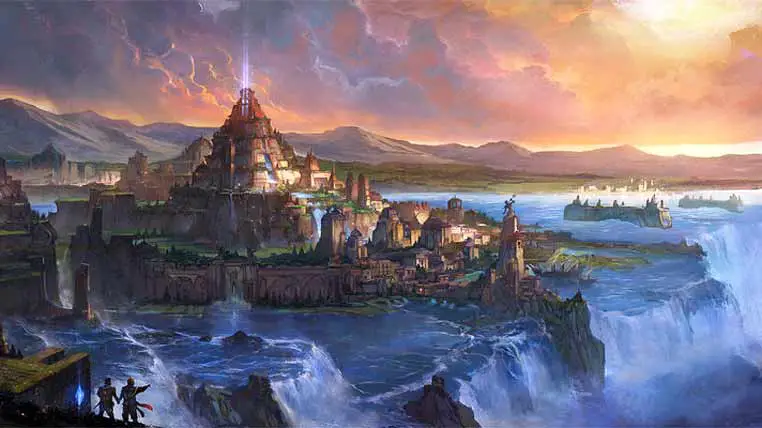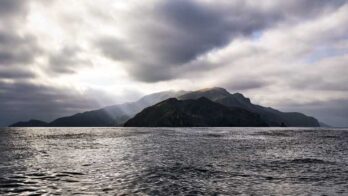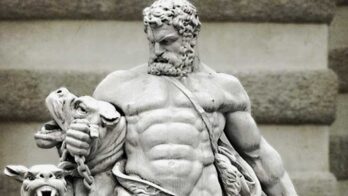Atlantis is a legendary lost city or continent that is said to have existed in the Atlantic Ocean.
According to the ancient Greek philosopher Plato, Atlantis was a powerful and advanced civilization destroyed in a catastrophic event around 9,000 years before his time.
Plato described Atlantis as a large island with a palace at its center, surrounded by rings and canals. The city was rich in resources and technology, with advanced architecture, agriculture, and mining.
The story of Atlantis has been the subject of much speculation and debate among scholars and enthusiasts, with many theories and hypotheses proposed about its possible location and existence.
However, little concrete evidence supports the idea that Atlantis existed. Most historians and archaeologists consider it a legend or myth rather than a real historical place.
The Legendary City of Atlantis
Over 2,500 years ago, the legend of an ideal society called Atlantis emerged.
This society was described as having abundant natural resources, remarkable engineering feats, great military power, and intellectual performances far more advanced than any other civilization of the time.
Atlantis was said to have existed on a fertile land with crystal-clear waters, abundant vegetation, and mineral wealth so great that the buildings were plated with gold.
Jewelry and other valuable objects were made from gold, as well as other metals and precious stones.
All manual labor was done by slaves, which allowed a vast elite to enjoy sports and cultural events, and to seek knowledge by studying mathematics, physics, biology, and astronomy, enriching an already flourishing society.
In the following centuries, no evidence of Atlantis’ existence was found.
Still, legends about it became even more fantastic, including engineering and technological abilities that increased its legendary status in the popular imagination.
In 1882, Ignatius Donnelly (1832-1901) published Atlantis: The Antediluvian World, where he strongly asserted that all civilizations have their origin in the Atlantean civilization.
He enumerated numerous connections between ancient civilizations located at great distances from one another, suggesting that similarities were a direct result of contact with the Atlanteans.
While undoubtedly similarities exist between various ancient cultures, there are also significant differences.
For example, myths about the worship of the Sun and the Flood could be based on some common teachings or represent reactions to nature’s destructive and beneficial elements.
Pyramids were built in Egypt and the Americas, but they differ significantly in structure.
The walls of the American pyramids did not converge to create a perfect pyramid shape, as in Egypt. Rather, their walls reached a certain level upon which a platform was built, often with a temple.
Suppose Atlantis disappeared sometime between 9500 and 8500 BC. What explains the immense time gap between when the Egyptian Pyramids were built (around 2500 BC) and the American ones (generally dated after 200 AD)?
It is difficult to reconcile such a gap with the theory of a single, advanced civilization that influenced all subsequent cultures.
It is more plausible that different societies developed similar technologies and practices independently rather than having a shared origin.
Since 1800, some have credited Atlanteans with technology capable of producing electricity, building flying machines, and utilizing nuclear energy for peaceful and warlike purposes.
Others claim Atlanteans knew of terrible death rays, the secret of levitation, and pure forms of energy provided by crystals.
Many enthusiasts of the Atlantis myth believe that the inhabitants of the lost continent had cosmic connections with extraterrestrials and could have even been a terrestrial colony of explorers from other worlds.
Plato's Description of Atlantis: A Closer Look
The story of Atlantis has fascinated people for centuries, inspiring countless works of literature and art.
However, the original description of this mythical land can be traced back to the works of the ancient Greek philosopher Plato.
Plato was born in Athens in the 5th century BC and was one of the most influential philosophers of his time.
He is best known for his dialogues, which explore various topics, including ethics, politics, and metaphysics. In two of these dialogues, Timaeus and Critias, he first describes Atlantis.
According to Plato, Atlantis was a highly advanced civilization that existed thousands of years before his time. It was located beyond the “Pillars of Hercules,” which most scholars believe to be the modern-day Strait of Gibraltar.
The Atlanteans were said to be powerful people who had conquered much of the known world, including parts of Europe and Africa.
Plato’s account of Atlantis goes on to describe the island itself and its society.
He portrays Atlantis as a utopia, a society governed by reason and virtue.
The people of Atlantis lived in perfect harmony with nature, and their rulers were wise and just. They were also highly skilled in the arts and sciences, including architecture, engineering, and agriculture.
Despite its idyllic nature, Plato suggests that Atlantis eventually became corrupt and arrogant, leading to its downfall.
The gods, angered by the Atlanteans’ hubris, unleashed a series of catastrophic events that ultimately led to the island’s destruction.
The survivors of this cataclysmic event were said to have spread their knowledge and wisdom throughout the world, helping to build other civilizations.
It is worth noting that Plato himself seems to have believed in the reality of Atlantis. In his dialogues, he presents the story as a factual account passed down from his ancestor Solon, who had heard it from an Egyptian priest.
However, many modern scholars believe that Plato used the story of Atlantis as a metaphor for his philosophical ideas.
For example, some suggest that Atlantis represents the ideal society, which can only exist in the realm of ideas.
A Tale of a Lost Civilization
For centuries, the legend of Atlantis has fascinated people with its tales of a lost civilization, advanced knowledge, and catastrophic destruction.
According to the Greek philosopher Plato (c. 428-348 or 347 BC), Atlantis was a perfect world of ideas, a land that existed before 8500 BC and flourished 8,000 years ago.
The city of Atlantis was located in the center of a series of concentric rings, with water rings serving as commercial canals and natural protections.
The story of Atlantis originated from Solon, a Greek statesman who heard about it from the priests of the Egyptian city of Sais, located in the Nile Delta.
According to the legend, Atlantis was a vast continent located beyond the Pillars of Hercules, which the Greeks named the rocks that form the Strait of Gibraltar, the westernmost point of Europe.
Beyond the strait lies the Atlantic Ocean.
The city of Atlantis was the most important of several cities on the continent.
It had palaces and temples where powerful rulers and erudites lived, and the coalition in power descended from Poseidon, the Greek god of the sea.
The Atlantean civilization promoted education, which generated progress in engineering and science, capable of making these lands fertile, beautiful, and powerful.
However, Plato writes that the Atlanteans became increasingly corrupt and greedy, putting their selfish goals above the common good.
They began to invade other territories with the idea of dominating the world. Furious with this development, Poseidon decided to destroy Atlantis, striking it with earthquakes and floods until it was swallowed up by the ocean waters.
Despite the legend’s popularity, no durable vestiges of Atlantis have ever been found, and the exact location of the lost continent remains uncertain.
Plato’s works, including the Timaeus and Critias dialogues, provide the most detailed description of Atlantis, but other Greek philosophers like Aristotle (384-322 BCE) regarded it as fiction.
The story of Atlantis has been linked to other catastrophic events, such as the Flood mentioned in the Bible and the Epic of Gilgamesh, as well as other ancient myths.
Some believe that the end of the Ice Age, between 12,000 and 10,000 BC, would have generated a rise in sea levels in different parts of the world and that earthquakes, volcanic eruptions, and profound accidental or associated climate changes of the Ice Age would have occurred in a period close to the dating of the destruction of Atlantis.
Where is the Lost City of Atlantis?
Atlantis has been claimed to be located on all seven continents and in various parts of the world’s seas and oceans.
Additionally, many of the wonders of the ancient world have been attributed to the Atlanteans, who supposedly fled their homeland’s destruction and spread their advanced scientific knowledge to other parts of the world.
The text of Plato’s dialogue suggests that Atlantis would have been located in the Atlantic Ocean, “beyond the Pillars of Hercules.”
Until the 20th century, the belief persisted that a land bridge once existed in the ocean, connecting Europe and the two Americas.
Such a concept of a connection between continents helps explain the similarities between flora and fauna on continents thousands of miles apart.
A chain of underwater mountains, known as the mid-Atlantic ridge, has been presented as the remnant of that land bridge or a vestige of Atlantis.
Jacques Collina-Girard from the University of Aix-en-Provence in the Mediterranean studied the patterns of human migration from Europe to North Africa at the peak of the last Ice Age, roughly 19,000 years ago, and his findings revealed the existence of an archipelago even at the spot where Plato wrote of Atlantis.
The existing island at that location was called Spartel and was situated in front of the Pillars of Hercules, off the Strait of Gibraltar, when the sea level was 130 meters lower than it is today.
According to Collina-Girard (New Scientist, September 2011), the gradual rise in sea level after the Ice Age caused the disappearance of an archipelago 9000 years before Plato.
Although the concept of an island swallowed by the sea near the Pillars of Hercules appears to be a valid theory, there is still no evidence to suggest that a continent ever existed in the middle of the Atlantic Ocean.
However, it is important to remember that the planetary ocean is still a great unknown. In fact, only about 20% of the planetary ocean has been mapped in high resolution, with the remaining 80% still needing to be explored.
There are several reasons why mapping the bottom of the ocean is so challenging:
Depth: The ocean is very deep, with an average depth of around 3,800 meters (12,500 feet) and some areas reaching depths of over 11,000 meters (36,000 feet). Mapping the seafloor at these depths requires specialized equipment to withstand extreme pressure.
Coverage: The ocean covers more than 70% of the Earth’s surface, making it a massive area to map. It also constantly changes due to tides, currents, and other natural phenomena.
Terrain: The seafloor is not uniform and is filled with underwater mountains, valleys, and canyons. This makes it challenging to create accurate ocean floor maps, especially in difficult access areas.
Technology: While technology has come a long way in recent years, mapping the ocean floor still requires specialized equipment, such as multibeam sonar and submersibles, which are expensive and not widely available.
Funding: Finally, mapping the ocean floor is costly, and there is often limited funding available for ocean exploration and research.
Despite these challenges, there has been significant progress in mapping the ocean floor in recent years, thanks to technological advances and increased funding for ocean exploration.
However, there is still much to be discovered and mapped in the depths of our oceans.
The shallow waters off the northwest coast of Africa, up to the Canary Islands, constitute an area that could have been dry land at one time and has also been suggested as a possible location for Atlantis.
However, no clues have been discovered here to suggest human habitation.
Alan F. Alford, an authority on mythology, investigated Plato’s story about Atlantis for five years.
In December 2001, he announced his conclusion that the myth had been invented by the ancient Greek philosopher.
According to Alford, Plato had concocted Atlantis as a metaphor for a contemporary version of the Big Bang theory. As a symbol of the lost paradise, Atlantis represented a kind of ultimate cataclysm that had generated the “beginning of time.”
The Strange Prophecy of Edgar Cayce
Despite the discouraging theories of skeptics, many people believe that Atlantis was a real, physical place that once existed on Earth.
In 1967, attention was drawn to Atlantis being located in the Atlantic Ocean, specifically near Bimini Island in the Bahamas.
This area excited many people searching for evidence of walls, roads, and buildings that were rumored to be underwater.
This excitement was fueled by the prophetic predictions of Edgar Cayce (1877-1945), a clairvoyant who could “read” the lives of his clients.
Cayce believed that many of the psychological traumas we experience in our current lives were caused by incidents that occurred in our past lives.
He told his clients that the physical or psychological traumas they had suffered or were going to suffer were caused by the suffering they had experienced when they lived thousands of years ago in Atlantis.
Cayce popularized an updated vision of Atlantis as a highly advanced civilization that had developed technologies like airplanes, submarines, X-rays, anti-gravitational devices, and explosives powered by crystals charged energetically from the sun.
He hypothesized that an explosion around 50,000 BC had fragmented Atlantis into five islands. Another explosion occurred in 28,000 BC, and a third – the one described by Plato – took place in 10,000 BC.
Cayce claimed that he had been an Atlantean priest around 10,500 BC, who had foreseen the future destruction and sent his followers to Egypt to supervise the construction of the Sphinx and the pyramids.
In 1940, Cayce predicted that the ruins of Atlantis would rise again near the Bahamas at the end of the 1960s.
In 1967, two pilots photographed a rectangular structure in the ocean off the coast of Andros Island, the largest of the Bahamas archipelago.
Another stone configuration in the shape of the letter “J” was identified by divers off the coast of Bimini Island, which was considered a stone road.
Large-scale diving expeditions became common in the area, and some explorers even claimed to have seen underwater temple remains, pillars, and pyramids. However, these claims have yet to be thoroughly documented.
The “J” shaped structure became popularly known as the Bimini Road and produced lively enthusiasm among Cayce’s followers and those convinced of the existence of Atlantis.
However, geological tests showed that it was actually a natural limestone formation.
The fractures in the formation create the appearance of a stone block construction. Still, the entire structure has the same grain and microstructure – a quality difficult to reproduce in several adjacent blocks.
Radioactive carbon testing of the shells embedded in the stone shows that the formation is relatively recent, dating back 2-3,000 years, which is much younger than the supposed moment of total destruction of Atlantis.
In the end, the curve of the “J” follows the shoreline of the neighboring island, suggesting that it was shaped by the same underwater currents that affected it.
On the other hand, the rectangular structure off the coast of Andros Island was indeed man-made. It was a depot built around 1930, where sponges gathered from the ocean waters were collected.
Despite these explanations, enthusiasm regarding the Bahamas site has remained strong. This could be because none of these conclusions can explain Cayce’s prophecy, not only about the exact location of the discovery but also about the period when it was to be made.
Archaeological Discoveries, Theories, and Other Potential Locations
Despite the lack of concrete evidence, the location of Atlantis continues to intrigue many.
Theories abound, with some suggesting that the lost civilization was once located in Antarctica, which was thought to have had a milder climate in ancient times.
Others have focused on regions that can be linked to Plato’s era, such as the island of Crete or modern-day Turkey.
Crete is where the flourishing Minoan civilization collapsed around 1400 BC. The other location, in modern Turkey, specifically Anatolia, has frequent associations with Atlas and his descendants.
Before the discovery of a grand palace at Knossos on the island of Crete by British archaeologist Sir Arthur Evans (1851-1941) in 1900, little was known about Minoan culture.
He named the culture that created Knossos and flourished in Crete the “Minoan civilization” after Minos, the legendary king of Crete.
The palace at Knossos was likely destroyed by an earthquake around 1700 BC, marking the end of an early phase in Crete’s history.
The Minoan civilization had regular commercial contact with ancient Egypt, southeast of Crete, across the Mediterranean.
Therefore, Crete is located west of Egypt, where the Egyptian priests told Solon that the lost continent was situated.
Archaeological excavations at the beginning of the 20th century unearthed remarkable artifacts of the Minoan civilization.
In 1939, Greek archaeologist Spyridon Marinatos (1901-1974) discovered pumice stone from a volcanic eruption on the island of Crete.
Marinatos associated the presence of volcanic ash in Crete with the violent eruption of the nearby island of Thera, which was recorded in ancient sources.
This eruption may have caused chaos in Crete and triggered a tsunami that flooded the island.
Marinatos compared the Thera eruption with the 1883 eruption of the Krakatoa volcano, which was heard thousands of kilometers away and generated giant waves that killed 36,000 people.
The volcanic ash that fell on Crete did indeed play a crucial role in preserving artifacts of the Minoan civilization, including entire streets, houses, frescoes, and ceramic objects.
However, Plato’s text only referred to earthquakes and floods without mentioning a volcanic eruption.
The date of the Thera eruption, circa 1500 BC, does not correspond to the period of the destruction of Atlantis, which, according to the Egyptian priests’ revelation to Solon, would have occurred 8-9,000 years earlier.
In 1969, Greek geologist Angelo Gelapoulous proposed a theory suggesting that all dates and measurements reported by Solon were exaggerated and that the figures he provided should be reduced by ten times.
While this theory provides some compelling correlations, it is valid only under certain circumstances.
Another problem with identifying the sinking of Atlantis with the destruction of the Minoan civilization is the inexact correlation between the eruption of Thera and the fall of ancient Crete.
The Minoan civilization continued to exist for a century after the volcanic eruption, as revealed by the archaeological excavations of the 20th century.
A layer of volcanic ash was found underneath a refined palace, indicating that building edifices continued after the eruption. Additionally, there was no interruption in the trade between the Minoans and the Egyptians.
While the volcanic eruption caused chaos in Crete, it did not entirely destroy the Minoan civilization.
The kings of Knossos reached the peak of their power around 1600 BC, controlling the entire Aegean basin and having intense trade with Egypt.
The subsequent destruction of the city of Knossos and the collapse of the Minoan civilization coincided with the beginning of the most flourishing period of the Mycenaean civilization in Greece.
This coincidence suggests that it is highly probable that the warriors of Mycenae attacked and destroyed the Minoan civilization.
The Search for Atlantis Continues
Lydia, an ancient country in Asia Minor (now Turkey), was situated between the valleys of the rivers Hermus and Cayster (today Gediz and Buyukmenderes). Previously known as Maeonia, it had fertile lands, gold and silver deposits, and a magnificent capital, Sardis.
Lydia prospered as a powerful dynastic monarchy after 685 BC. In the 6th century BC, Lydia flourished under King Croesus. The empire was destroyed by the Persian King Cyrus the Great (c. 585 – c. 529 BC), who conquered Sardis around 546 BC.
After the defeat of Persia by Alexander the Great (c. 356-323 BC), the king of Macedonia, Lydia was brought under Greco-Macedonian control. In 133 BC, it became part of the Roman province of Asia.
Lydia was separated from Greece by the Aegean Sea. One of its legendary kings was named Tantalus, a name similar to Atlantis, which had many mythological attributes identical to the Greek god Atlas. Like Atlas, Tantalus was the leader of the Titans, the divine creatures defeated by Zeus.
In Greek mythology, Zeus punished Atlas by driving him west and forcing him to bear the heavens on his back. A similar fate befell Tantalus in the myths of Anatolia (the last name of Asia Minor, now in Turkey).
According to legend, Tantalus ruled a fabulous, wealthy city that he founded on the mountain of Sipylus in Lydia. His city was shaken by earthquakes and affected by floods, and it is said to have been swallowed by the waters when Tantalus fell out of grace with the Olympian gods.
After 1990, ruins were discovered on the northern slope of Sipylus Mountain. The region has undergone numerous changes over the centuries.
Among the vestiges is a statue of the goddess Cybele, dated around 1400 BC, when the Hittite domination of the area was overturned by locals affiliated with the Mycenaean civilization of Greece.
Tantalus’s territory had been conquered, and his city may have been wiped off the face of the earth or later destroyed by an earthquake and swallowed by a lake. The area is located on a tectonic fault with exceptionally high seismic potential.
In the fifteenth century, an earthquake occurred here, causing considerable damage to the cities of Lydia. Among the most severely affected was the city of Magnesia on Sipylus, in the region where Tantalus used to be.
Lake Saloe in Turkey was long identified as the lost city of Tantalus. The lake was drained in modern times, and its surface was restored to agriculture.
Now it is a fertile plain guarded by rivers. An ancient caravan route was found, and while it is not a relic of a mighty empire, the attractive prospect that Tantalus was, in fact, Atlantis, remains standing.
Enthusiasts of the lost continent were stirred up again in December 2001 when explorers, using a bathyscaphe to survey the seabed off the coast of Cuba, announced the discovery of stone structures at a great depth in the ocean, giving the impression that they could be the ruins of an unknown ancient civilization existing thousands of years ago.
Representatives of the Canadian company Advanced Digital Communications and experts from the Cuban Academy of Sciences claim that the structures were discovered at a depth of about 700 meters, distributed as if they were remnants of an urban area.
It is estimated that this ancient city sank about 6,000 years ago, 1,500 years older than the great Egyptian pyramids.
If this new exciting site is Atlantis or rather an evidence of a strip of land that once connected Cuba to Latin America remains a controversial issue.
At Ancient Theory we only use trusted sources to document our articles. Such relevant sources include authentic documents, newspaper and magazine articles, established authors, or reputable websites.
- Robert Hackforth - The Story of Atlantis: Its Purpose and Its Moral.
- Kenneth Feder - Frauds, Myths, and Mysteries: Science and Pseudoscience in Archaeology. McGraw-Hill Education, 2010.
- Helen Dawson and Philip Hayward - Submergence: A special issue on Atlantis and related mythologies. [Source]
- Gerard Naddaf - The Atlantis Myth: An Introduction to Plato's Later Philosophy of History. Classical Association of Canada, 1994.
- Atlantis - wikipedia.org. [Source]
- The Lost City of Atlantis - The Facts - Unexplained Mysteries. coolinterestingstuff.com.
- Willie Drye - Atlantis. nationalgeographic.com.
- Sarah Pruitt - Top 6 Theories About Atlantis. history.com.
- Atlantis Legendary Island - britannica.com. [Source]
- Benjamin Radford - Lost City of Atlantis: Fact & Fable. livescience.com.
- Shamseer Mambra - Top 10 Amazing Facts About the Lost City of Atlantis. marineinsight.com.






